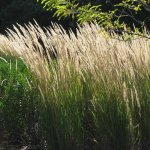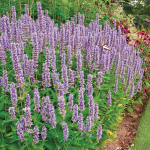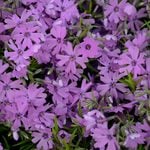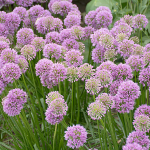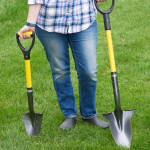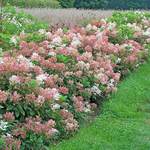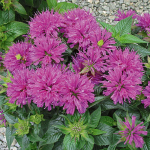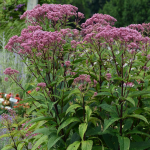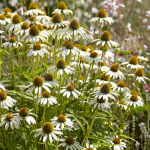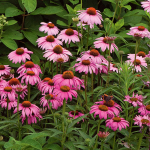Product Details
Are you new to gardening? Do you have a garden bed in full sun that you would like to transform into a beautiful, colorful oasis? Our Start a Garden for Sun contains 8 different perennials (plants that return year after year) that thrive in the same conditions: 6+ hours of direct sun per day and well-drained soil. The plants were chosen by our horticultural experts to provide ease of care and a long season of interest. 1 plant of each variety listed below, 8 plants total. Covers approximately 25 sq ft. Planting diagram included.
Before purchase, you’ll need to know your USDA Plant Hardiness Zone. This will determine whether or not the plants in this collection are hardy in your area and able to tolerate regional extremes of heat and cold. Click here to learn more about hardiness zones and to find yours. If your zone is between 5-8, this garden is for you.
What can you expect?
Springtime brings the variegated foliage of an Iris pallida (Sweet Iris). You will receive Iris pallida ‘Variegata Aurea,’ which has yellow-and-green blades OR Iris pallida ‘Argentea Variegata,’ which has ivory-and-green foliage. Both plants produce the same fragrant, violet-blue blossoms in late spring. The blades of the Iris add season-long vertical interest, and they contrast nicely with the mounding, gray-green foliage of Nepeta (Catmint) ‘Walker’s Low,’ a Lavender look-alike that begins producing purple-blue, pollinator-attracting flowers in late spring.
As summer arrives, the carmine-pink Daisy-like flowers of Echinacea purpurea (Coneflower) ‘Magnus’ appear, attracting butterflies and bees to the molasses-colored cones.
The globe-shaped flower heads of Allium ‘Millenium’ generally follow next, their playful forms floating above sprays of flat, grass-like foliage, adding another irresistible attraction for gardeners and pollinators.
With the arrival of autumn, some of the perennials subside, setting the stage for Symphyotrichum oblongifolium ‘Raydon’s Favorite.’ This Aromatic Aster brings a multitude of Daisy-form, lavender-blue blossoms to the garden, providing a late-season food source for butterflies and other pollinators.
Offering a full season of interest but peaking later in the season are three more fabulous perennials:
Calamagrostis x acutiflora ‘Karl Foerster’ lends this collection its high point. It is a well-mannered, upright Ornamental Grass that creates a visual exclamation point in the garden. New growth emerges green, but in late spring, feathery flower spikes emerge and begin shading to toasty brown as the season progresses. The grass sways in a breeze, adding movement to the garden.
Stachys byzantina (Lamb’s Ears) ‘Big Ears’ is a favorite with children for its broad, velvety gray leaves. Gardeners appreciate its long season of interest as a ground cover. Plants also produce upright stems topped with lavender-purple flowers in summer, but this favorite is generally grown for its foliage.
Bushy Sedum ‘Purple Emperor’ creates a colorful accent with plump, succulent foliage in dramatic shades of glossy dark purple. Clusters of pinkish-purple flowers appear in summer, attracting pollinators.
Plants in your Start a Garden collection will arrive in one of two forms: potted and/or bareroot. Bareroots may sound intimidating, but they’re not. In fact, they’re remarkably easy to plant. Visit the Growing Guide (see tab above) to learn more now or consult the Quick Start Guide you will receive when your new garden arrives.
Enjoy this garden of beautiful, sun-loving stalwarts for years to come. We hope it’s the start of many great gardening adventures.
For more information on growing and care, click Growing Guide.
Shipping
HOW PLANTS ARE SHIPPED
The size of the plants we ship has been selected to reduce the shock of transplanting. For some, this means a large, bareroot crown. Others cannot travel bareroot or transplant best if grown in containers. We ship these perennials and annuals in 1 pint pots, except as noted. We must point out that many perennials will not bloom the first year after planting, but will the following year, amply rewarding your patience. We ship bulbs as dormant, bare bulbs, sometimes with some wood shavings or moss. Shrubs, Roses, vines, and other woody plants may be shipped bareroot or in pots. The size of the pot is noted in the quick facts for each item.
WHEN WE SHIP
We ship our bulbs and plants at the right time for planting in your area, except as noted, with orders dispatched on a first-come, first-served basis by climate zone. We also ship a wide range of containers and planters, tools, supplies, fertilizers, garden wear, garden decor items, as well as indoor decorations like wreaths and dried bouquets when available. Estimated dates for shipping are indicated in the green Shipping Details box for each item. Please supply a street address for delivery. Kindly contact us with two weeks notice, if you'll be away at the expected time of delivery.
OUR GUARANTEE
We guarantee to ship plants that are in prime condition for growing. If your order is damaged or fails to meet your expectations, we will cheerfully replace or refund it. Please contact our Customer Service Department at 1-800-503-9624 or email us at [email protected]. Please include your order number or customer number when contacting us.
Reviews
Average Customer Rating:
 (1 Review)
Write a Review
(1 Review)
Write a Review
Sort by:
Love it! 
A viewer from Rhode Island
Growing guide
Welcome to the world of gardening & our Start a Garden series
Growing Your Start a Garden for Sun
Your Start a Garden for Sun contains 8 different perennials (plants that return year after year). They were selected by our horticultural experts to provide ease of care and a long season of interest. They also provide sources of food and habitat for winged creatures. All prefer the same growing conditions: full sun (defined as 6+ hours of direct sun per day) and well-drained soil. Once established, these plants are tolerant of drought and heat. Deer generally avoid them.
As you begin your first garden adventure, keep in mind that newly planted perennials need time to settle in and establish roots. In their first season, they will divert much of their energy to this endeavor. As a result, your plants may or may not produce flowers in their first year. Waiting for plants to settle in and grow is a process by which many gardeners begin to develop one of the most important traits a green thumb can possess: patience. Experienced gardeners know that in a first year, a perennial “sleeps.” In the second year, it “creeps.” And by the third year, it “leaps.” Watch over time as your perennials gain in size, forming broader clumps and increasing their foliage and flower shows. As a general rule, expect your plants to reach their mature size in three years.
This guide includes the following sections:
- Knowing & Growing Your Plants
- About Bareroot Plants
- Laying Out Your Garden
- Caring for Your Garden
- Companions
- Calendar of Care
The plants in the Start a Garden for Sun are ordered below roughly in order of their peak season of interest. The plants near the top of the list blossom ahead of those near the bottom:
- Iris pallida (Common Name: Iris)
Iris pallida is a striking, full season attraction in any sunny garden. Gardeners value it for blade-shaped, striped foliage that emerges early and keeps its good looks into autumn. Summer brings lavender-blue flowers that fill the garden (and vases) with heavenly perfume. Iris pallida grows best in full sun but can tolerate part shade. It prefers moist, humusy, well-drained soil. Once established, it can tolerate drier conditions. It flowers in late spring. Once the blossoms have subsided, remove the entire bloom stalk while keeping the leaves. They will continue to add a notable vertical accent to your garden until they turn brown in fall. At that point, cut them back almost to the ground. Iris pallida does not need to be fertilized. When mulching the garden, be careful not to cover the entire rhizome. These plants are happier when a portion of the rhizome is situated just above the soil level. If in subsequent years your Iris needs to be divided, this is best done in late summer. Iris spreads gradually by growing new “fans” of leaves next to the original plant. Enjoy these new plants where they are, transplant them to other areas of the garden, or share with friends. Iris pallida is a remarkably low-maintenance plant with no serious pest or disease problems.
- Stachys byzantina (Common Name: Lamb’s Ear)
Stachys byzantina are grown primarily for velvety, silvery leaves that make a superb ground cover, and for pastel purple flowers that appear on upright stems in summer. Plants prefer full sun and evenly moist, well-drained soil. Once established, they are tolerant of drought. They dislike hot, humid summer days, which can result in yellow, spotty, dead, or discolored foliage. If you see that develop, pull off the afflicted leaves. New growth will generally reappear in late summer or fall when humidity tends to wane. Stachys gradually form a spreading clump. Remove spent flower stalks at the base. While Lamb’s Ears is a longtime favorite of gardeners, deer generally avoid it.
- Nepeta (Common Name: Catmint)
Experienced gardeners regard Nepeta as one of the great “unkillables.” Often confused with Lavender, especially when seen from a distance, these essential plants of the sunny or part-sun garden are tough, carefree, and generous. They offer a long season of interest that begins with the emergence of aromatic gray-green foliage in early spring and extends into autumn. Plant Nepeta in full sun or partial shade, and in well-drained soil. Established plants can tolerate drought. Nepeta blooms fully in early summer, sending out spikes of lavender-purple flowers that bees and other pollinators adore. After the first full flush of bloom subsides, cut plants back by two-thirds to keep them compact and tidy and to encourage repeat bloom. Plants will flower intermittently for the duration of the season. These durable, hardy, pest free perennials are also deer resistant.
- Sedum (Common Name: Stonecrop)
Expect a long season of interest from this sun-loving garden favorite. It produces distinctive succulent leaves early in the season, tops them with clusters of tightly budded flower heads in summer, then waits for late summer, a time when many garden plants are subsiding, to open its blooms and create an evolving color show while also providing food for pollinators. This perennial thrives in sandy soil with average to medium fertility. Good drainage is especially important. If plants are grown in too much shade or soil with too much moisture or fertility, they will produce weak, floppy stems. Established plants tolerate drought, making them a superb choice for water-wise gardens. Mature plants may require staking. The dried flower heads of many Sedum varieties remain attractive in winter, whether left standing in the garden or brought indoors. Plants spread slowly.
- Achillea millefolium (Common Name: Yarrow)
Carefree Yarrow is a favorite in sunny gardens with well-drained soil. These garden stalwarts produce clumps of distinctive, finely textured foliage. They flower in late spring and summer, producing flat-topped flower clusters that serve as landing pads for pollinators including butterflies. Once established, these perennials are tolerant of drought. Water them only when the weather has been very dry. The plants require little fertilizer. They are generally free from disease and insect pests but they will tend to fall over if grown in shade, are over-fertilized, or kept too wet. Encourage repeat bloom by removing spent flowers just above the buds of new flowers or cut back the entire stalk close to the ground. Achilleas are irresistible to butterflies. Flower arrangers take note: They also make an excellent cut or dried flower.
- Echinacea (Common name: Coneflower)
Echinaceas are surely among the most recognizable plants in any garden. Their shuttlecock-shaped blossoms with prominent central cones are a fixture in sunny borders and meadows where they attract pollinators in summer. Goldfinches will perch atop the cones in autumn to feast on the seeds. These carefree perennials prefer full sun and well-drained soil, and in return, they bloom over a long season from summer to fall. They do not need fertilizing. Once established, the deep taproots of Echinaceas make them quite tolerant of drought. They are rarely troubled by pests or diseases. Deadheading is not required, but if the flowers are cut back after subsiding, more blooms will appear. If you like, deadhead spent blooms early in the season but leave later-season flowers to set seeds that will provide food for the birds. Echinacea flower stems may be left standing through winter. The seed heads will collect snowflakes, creating pretty little puffs. Plants rarely need dividing, but if you decide to divide or move an established Echinacea, keep in mind the long taproot goes deep into the soil. Dig down to include as much of the root as possible. It is best to divide or move plants in late fall or early spring when they are dormant.
- Aster/Symphyotrichum (Common Name: Aster)
Asters, some of which are now classified as Symphyotrichums and Eurybias, are indispensable plants in the late-season garden. They erupt into bloom, adding vivid color to borders and beds at a time when many other perennials are subsiding. They also provide a source of food for pollinators in late summer and fall. Plants prefer full sun and moist, well-drained soil. They tolerate sandy and clay soils but are not equipped to handle drought. You may cut back plants by half June to facilitate branching, which will result in more flowers. Asters blossom in late summer through fall. Consider leaving the dried flower heads in the garden to provide a late-season source of food for birds. When planting, give Asters plenty of space because their stems tend to billow out later in the season. These carefree perennials are largely untroubled by pests and diseases and deer do not find them palatable.
- Calamagrostis (Ornamental Feather Reed Grass)
Calamagrostis acutiflora ‘Karl Foerster’ is a favorite of landscape designers and for good reason. This Ornamental Grass has an upright silhouette and tidy growing habit that creates a strikingly vertical accent in any garden. The green blades form a base for feathery flower spikes that rise up in summer and gradually change in color to a toasty brown. They sway in the slightest breeze, adding movement to the garden. Single specimens serve as an exclamation point in any garden. Multiples can be planted in a row to form an airy screen or spaced apart in a long border to create a visual rhythm amid mounding perennials and smaller shrubs. This grass prefers full sun and moist well-drained soil, but it tolerates clay soil as well. Too much shade will cause foliage to become floppy, and plants will produce fewer flowers. Do not allow soil to dry out. ‘Karl Foerster’ can be cut back in late fall or you may keep the foliage for winter interest. If you choose the latter, cut back the clumps to a few inches in late winter, just before the new shoots appear in spring. The dried grass can be composted or used as mulch. This clump-forming grass may die out in the center and need dividing every few years. Dividing and transplanting is best done in spring. ‘Karl Foerster’ is free of significant pests and diseases and is deer resistant.
Plants in your Start a Garden collection will arrive in one of two forms: potted and/or bareroot. Bareroots may sound intimidating, but they’re not. In fact, they’re remarkably easy to plant.
Bareroots are exactly what the term would imply: a healthy division of a mature plant to include a portion of its roots (minus most or all green growth and soil) and a portion of the crown (the point where a plant’s roots meet its stems). Depending on the type of plant, these roots may present themselves in a broad array of shapes and sizes – from the knobby looking chunks of a Liatris to the wisps of an Astilbe (which often trail a mass of delicate roots). Bareroots don’t look like much on arrival, but they are the beginnings of beautiful plants. Most bareroots are shipped packaged in damp sawdust or shredded paper. Plant them as soon as possible upon receipt or keep them in a cool, dark place (such as a basement or a closet) for up to 2 weeks.
To plant bareroots:
- Remove and discard the packaging material
- Save the plant tags, which provide helpful information and may also serve to mark a planting site
- Soak bareroots in water for 1 hour to rehydrate them then plant at the depth recommended on the plant tag
- Water thoroughly
- Depending on when bareroots are planted, they will take some time to settle in and develop root systems
If your bareroot is planted in spring, it will gradually begin pushing up top growth and you’ll see the emergence of leaves and stems as the plant begins to grow above ground. If your bareroot is planted in fall, it will develop a good root system and may send up a few leaves before going dormant for winter. Top growth will emerge in spring as the days grow longer and sun warms the soil.
If you experience a bit of trepidation with your first bareroots, the ease of planting them and their vigor once settled will win you over in no time. In the span of a single season, they become established plants that are poised to perform like champs in your garden.
To lay out your garden to best advantage, first see the Planting Plan that is included in your box. (You can also find it on the product page on our website. Search SKU # 87523.) Keep in mind that you don’t have to position your Start a Garden for Sun plants exactly as we show them in the plan. Our diagram is just one possible design based on the heights, shapes, and compatibility of the plants. Your garden bed may have different dimensions, you might wish to tuck your plants into several areas, or you could use them to flank a path so you can stroll through the garden.
As you lay out your garden, keep in mind the following: The plants selected for the Start a Garden for Sun are all medium in size, except for the Calamagrostis (Ornamental Grass) ‘Karl Foerster,’ which is taller and very upright. Echinacea (commonly called Coneflower) is another vertical grower. The stems of these perennials can reach up to 36" tall, making them a fine companion in both form and spirit for the Calamagrostis. Site the Ornamental Grass and the Coneflower together at the back of your garden or position them in the center if your garden can be viewed from all sides. The Nepeta and Aster both produce mounding forms. Nepeta blossoms early in the season. The Aster flowers later. Both are sized just right to function as transition plants – from tallest (Calamagrostis) to medium (Aster, Nepeta, Iris) to shortest (Sedum, Stachys byzantina, Allium). The Iris pallida adds a medium-size vertical accent, its variegated blades emerging early in spring and continuing straight on into autumn. We tuck the Iris in front of the taller plants. The Sedum, Stachys, and Allium are the shortest, so they should ideally be positioned at the edge of the garden. Be sure to provide extra space around the Aster to give it room to billow out.
The mature height and recommended spacing for each perennial can be found on the plant tag. (It’s best to keep these tags and put them in the ground alongside your perennials. That way, you’ll remember which is which, and, in periods of dormancy when perennials die back to the ground, you’ll know where you planted them.) Keep in mind that garden design is flexible and plants are forgiving. As your perennials settle in and grow, you may or may not like the arrangement. If you are not pleased, take advantage of mild conditions in spring or fall to gently dig up your plants and relocate them to create a more agreeable design.
Light: The plants in this collection all thrive in full sun, which is defined as 6+ hours of direct sunlight per day.
Watering: Immediately after you plant your new perennials, water them well to settle the soil around them. In the weeks and months that follow, hydration will be key to helping your plants become successfully established. Pay attention to how wet or dry the soil is – you don’t want to let the plants dry out entirely, but they will suffer if they are in constantly wet soil (the roots may rot). The best way to assess the moisture level in your soil is to stick your finger in to a depth of 1”. If the soil feels moist, do not water. Wait until it feels somewhat dry. The general rule is that new plants need approximately 1” inch of water per week whether it’s supplied by Mother Nature, your garden hose, or a watering can. Once your plants are established, they will need watering only during periods of prolonged drought (i.e., no rain for several weeks). If possible, avoid overhead irrigation. It is best practice to water plants at the soil level, which means wetting the ground around and between them but not spraying directly on or at them. Water sprayed on leaves can promote fungus and disease. Another important rule of successful hydration is to water plants deeply and infrequently. Why? Watering daily or too frequently in small amounts encourages plants to produce shallow roots, which may not be sufficient to sustain them during dry spells. Watering deeply and infrequently encourages root growth well below the surface of the soil, which is where plants are likely to find moisture in times when rain is scarce.
Fertilizer, Soil & pH: There is no need for fertilizer at the time of planting and doing so can negatively impact a plant’s proper development. Instead, we hope you and all new gardeners will develop what is widely regarded as best practice when it comes to using fertilizer: In lieu of feeding individual plants (which is often encouraged by some companies that sell chemical fertilizers and additives), think in terms of feeding the soil which, in turn, will nourish your plants naturally. It’s easy: After your perennials have had a year to settle in, apply 1-2” of organic matter, such as compost or well-rotted manure, around the base of the plants in early spring. This will take care of their nutritional needs, and no additional fertilizer will be necessary. All of the plants in the Start a Garden for Sun collection are adaptable to most soil types but they prefer a sandy, well-drained loam with a neutral pH from 6.0 to 7.0. Testing your garden soil’s pH is not a requirement (some of us here at the farm have never done it in our home gardens while others swear by it). To learn more about soil testing and how to go about it, click here.
Pests/Diseases: The plants in this garden are generally free from diseases and insect pests. But like any plants, they are most susceptible to disease when faced with stressful conditions. Eliminate the stress for your plants by providing them with what they need: full sun, proper watering, and good drainage.
Reflowering: Deadheading is the process of removing spent blossoms to encourage the formation of additional flowers, prevent unwanted seedlings, and/or improve the appearance of your plant. [See plant descriptions above for specifics about deadheading the individual plants in this collection.]
Dividing/Transplanting: Allow your plants to fill out for a few years. It’s OK to let them touch and grow together. But if plants begin to appear crowded, which can impede good air circulation and force them to compete for resources, you may choose to divide some, including clumps of the Calamagrostis. Division is best done in early spring or fall when temperatures are most likely to be mild. (The higher heat of summer can stress plants, making division and transplantation a bit more perilous.) To divide your plants, use a shovel to dig up a section or the entire root ball. Using the blade of the shovel, chop the root ball into sections or, if the divisions separate easily, use your hands to tease them apart. Transplant the divisions to new areas of your garden, use them to fill in any gaps, or share with friends and family. Echinaceas generally do not need dividing.
The following plants thrive in the same growing conditions as the perennials in your Start a Garden for Sun. They would all make fine additions to your garden.
- Hummingbird Mint (Agastache)
- Moss or Garden Phlox (Phlox subulata or Phlox paniculata)
- Coreopsis
- Salvia
- Bee Balm (Monarda)
Early Spring: Cut back remaining stems and stalks from the previous season. The Ornamental Grass can be cut back to a few inches. If you want to keep your Sedum fairly compact, pinch back the tips of new spring growth by one-third when the stems are 4–6″ tall. Weed the garden and, every year or couple of years, depending on the vitality of your plants and the condition of your soil, you may wish to apply a 1” layer of compost after the plants have emerged. The compost will enrich the soil, which provides food for the plants. For best results, apply the compost around the base of the plants, not on top of them.
Late Spring: When the first flush of bloom on the Nepeta has subsided, cut it back by two-thirds. This will tidy its form and encourage rebloom, which will happen intermittently for the remainder of the season. Once the ground warms, a light 2-3” layer of mulch will help conserve moisture in the soil and insulate roots. Do not cover the rhizome of the Iris with mulch. It prefers to have the rhizome partly exposed just above the soil line.
Summer: Be sure plants are getting enough water. If weather conditions are dry, monitor the soil for moisture (see above under Caring for Your Garden — Watering) and, if necessary, get out the hose or watering can. Keep in mind that plants in their first season need roughly 1” of water per week. Weed to remove unwanted plants that can crowd or take nutrients away from your plants. After the Iris has finished blooming, remove the flower stalks completely, but keep the leaves.
Fall & End-of-Season Care: Depending on how you want your garden to look in late fall and through winter, all plants can be cut back to the ground once they finish blooming or you may choose to leave some of them standing. We recommend keeping some of the spent foliage, flower heads, and stems in place to provide food and shelter for wildlife including overwintering butterflies and their larvae. The dried blossoms of Echinacea are particularly attractive to goldfinches, which perch atop them to feast on the seeds. Sedum flower heads are lovely capped with snow. The blades of the Iris will turn brown, generally after the first hard frost. You may cut them back to the ground. The grassy foliage of the Allium and perhaps a few of its spent flower heads may be cut back in late autumn or in early spring. If you live in a colder region, applying a light 2-3” layer of mulch around your plants in late fall is as beneficial as a winter coat.
To learn more, see our Expert Resources for New Gardeners.
To download a PDF of our New Gardeners Handbook, click here.
To download a PDF of our Glossary of gardening words, click here.

